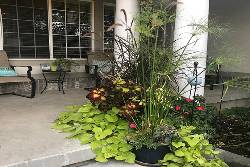Seven Tips for Container Gardens that Thrill, Fill and Spill
May 25, 2018
Ask a Specialist: Seven Tips for Container Gardens that Thrill, Fill and Spill
Container gardening has become popular as planting areas in the landscape have become smaller. Some containers are used to grow vegetables or specimen shrubs, w hile others display a beautiful splash of color. For thrilling container gardens, consider these tips.
hile others display a beautiful splash of color. For thrilling container gardens, consider these tips.
• Containers need large enough drainage holes in the bottom to prevent soil from clogging the hole while still promoting proper drainage. If the drainage hole is too large, soil will leak through the bottom each time the container is watered. Prevent this problem by placing a large rock or solid object over the hole. This allows water to drain around it and keeps the soil in place.
• Planters must be large enough to accommodate the root system of the plants. Often, annuals or vegetable plants are crammed into a small planter, and then gardeners wonder why the plants stay small or need excessive amounts of water. As a general rule, any pot 8 inches or smaller in diameter will only hold small plants. Most annual or perennial containers should be a minimum of 8 to 10 inches in diameter, and larger pots are more desirable. After all, the goal of having annuals is to make a large splash of color in the landscape, not a dribble.
• There is an art to designing annual containers, often referred to as thrill, fill and spill. This refers to the principle of placing an upright plant in the center of the container that “thrills” the eye and draws attention. Next, the planter is “filled” with an accenting color and finally one or two plants are placed to “spill” over the sides to soften the appearance and extend the color.
• The spike dracaena is commonly used as a center “thrill” for planters; however, many other plants work equally well to catch the eye. Some include red fountain grass, snapdragons, geraniums, salvia, coleus and dahlias. These plants reach a height of 8 inches or more and stand out in a crowd of annuals.
• There are a number of good choices for “filling” a container with annuals. The most important consideration is to select colors and flowers you like. Next, keep in mind that they should not overpower the plant used to “thrill” nor hide the plants that “spill.” Osteospermum, million bells, bidden, some zinnias and impatiens work well.
• For plants that “spill,” there is the black-eyed Susan vine, wave petunias, sweet potato vine, licorice plant, alyssum and lobelia. Some of these plants also climb, which can be both a plus and a problem when they attempt to take over the basket or move up a post. For this reason, flower baskets should be pruned as needed.
• A critical component in the container is the soil. It should hold water, but also drain. A number of good potting soils are available at local nurseries and garden centers. Keep in mind that you get what you pay for when purchasing potting soil. Along with the proper soil, it is important to provide the plants with sufficient fertilizer. Normally this means either applying a slow-release fertilizer at planting time or using a water-soluble fertilizer every couple of weeks.
Stay tuned for Extension’s live online container gardening course to be held in August. For additional gardening information, visit Garden.usu.edu.
By: Jerry Goodspeed, Utah State University Extension horticulturist, 435-919-1276, jerry.goodspeed@usu.edu


 Utah 4-H & Youth
Utah 4-H & Youth